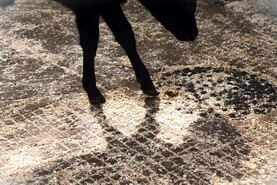Preparations are in full swing for breeding in the next two weeks and sexed semen is once again a hot topic of debate.
I see that in Denmark, home of the famous Danish Jersey, all Jersey bulls have been mandated to be sexed to prevent the birth of more Jersey bull calves.
This should be the bare minimum in my opinion here as well. I’ve felt for a long time that the industry here has dragged its feet on this area.
We’ve all seen what’s happened in New Zealand in terms of calf welfare issues. We need to ensure that the Irish public can have faith that our sector won’t fall into the same welfare pitfalls.
While some farmers are still sceptical of the conception rates for sexed semen, on our own farm it’s been a great success.
Favourite job
Selecting bulls has always been one of my favourite jobs, the opportunity to improve the genetics of the herd for generations to come is a passion of mine. Selecting bulls and then seeing how their heifers turn out is the part of farming I most enjoy.
We moved to 100% sexed three years ago. This has opened a whole new focus on the farm. Sexed helps accelerate the genetic gain even if it requires tighter fertility management.
This tactic has proven so successful that we’ve actually had excess heifers for the past few years
The conception rate is definitely a downside - we average 50% overall with sexed AI, with some bulls much lower and others higher. However, this ensures that we only breed the earliest calvers and the most fertile to a single serve of dairy AI.
This tactic has proven so successful that we’ve actually had excess heifers for the past few years. This year, we’re planning only three weeks dairy AI, followed by a week of beef AI, then straight to two Angus bulls.
Prices at their best
That means we also don’t have to worry about dairy bulls. For the most part, we can focus on calving down high-terminal beef bulls earlier in the season when prices are at their best.
At the moment, our best sellers are Limousins, but we’ve also used Aubrac, but their similar look to a Jersey doesn’t excite our buyers.
A more novel approach I’m trying this year is a few Wagyu straws, more an experiment than anything.
A shapey Angus always sells well; they make up 60% of what we sell each year.
The poor quality of calves and losing an outlet for those calves is a big risk to the whole sector, bigger than any other risk I can think of right now.
Completed jobs
Back on farm, everything from vaccinations to freeze-branding has been completed.
The teaser bulls have been let loose with their chin-balls attached. Already, most of the cows have been tail-painted and any heats safely recorded via the phone.
Over the years we’ve brought more diversity into the herd, in both traits and colour. The backbone remains, and will remain, high-EBI Holstein.
However, first Norwegian Reds were added, then Jerseys, with the occasional Montbéliarde.
We operate three-way crossing on the crossbred cows, so a Norwegian-cross-Holstein will get Jersey and vice versa.
This produces a mid-size red or speckled with high health traits and good percentages.
However, while farmers are considering the future of their herds for next year, we need to know that the industry has our back for the years to come and that includes ensuring a good selection of sexed semen bulls is available.






 This is a subscriber-only article
This is a subscriber-only article










SHARING OPTIONS: